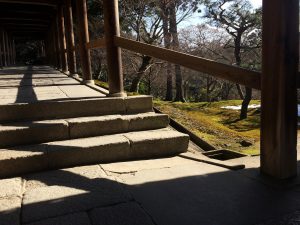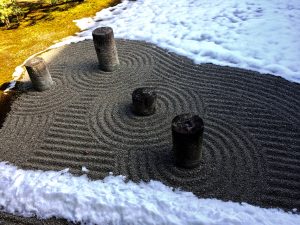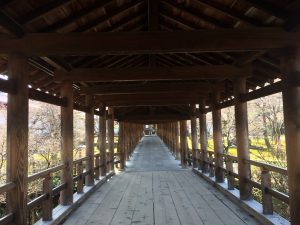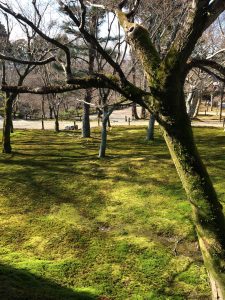As I reflect on our trip to Kyoto, I can’t but draw parallels to a Noh performance. The trip hadn’t been ‘rehearsed’ because it was the first time it was being offered, and bringing the trip into reality took months of collaboration, preparation, and planning beforehand by numerous people in the US and in Japan. Recognizing this, I’d like to begin my reflections with a huge thank you to Yamamoto-sensei, Sachi-san, Jessy, Diego, Professor Ludvik, and all of the artisans who welcomed us into their studios and graciously shared their knowledge with us. I’m also very grateful to have shared the experience with fellow Williams students who had so much enthusiasm and so many thoughtful perspectives and questions. Having the time and space to get to know everyone on the trip was a really rewarding part of the whole experience. Ultimately, the coming together of such remarkable people in such a special place for such a short time gave the trip a feeling of ichigo ichie – a once in a lifetime experience. This feeling was made all the more powerful by the knowledge that some of the artisans whom we met had no successors and therefore represented the last artisans in a long line of tradition.
Just as Noh is a collaborative or composite art form that brings together a variety of traditions and arts that are spectacular in and of themselves (the music, dance, costumes, mask, storytelling, singing, staging, etc), our trip also had a lot of experiences that could stand alone but became even more powerful and meaningful when brought together. Each visit to an artisan gave me a deeper knowledge of and appreciation for that particular art form. At the same time, having the visits in a short span of time and then synthesizing them even further in the final presentation when all of the artisans came together helped me think more broadly about tradition, modernity, art, and what it means for something to be Japanese.
When one first compares the art forms we studied, tea ceremony seems to be the most rooted in philosophy, and the phrase ‘The Way of Tea’ expresses this idea that tea ceremony is a way of life. Ultimately, however, I really felt that the all of the art forms we learned about were more than just crafts or creative endeavors but, like tea ceremony, could be understood as philosophies of life and ways of being. I saw and felt how the four principles of tea ceremony – wa, kei, sei, jaku or harmony, respect, purity, and tranquility – were present in each of the art forms and throughout Kyoto. These principles permeated the art and atmosphere of Kyoto to such an extent that I found myself profoundly affected by them, and as I learned about Kyoto’s traditional art and travelled through the city, I felt inspired, rejuvenated, balanced, and mindful.




I’d initially wanted to go on this trip to immerse myself in a different environment and culture, to learn about art forms, to think about tradition and modernity, to deepen my connection with Zen Buddhism, and to have a rejuvenating experience after an exhausting first semester. This trip definitely provided me with all of those experiences and did so in a way that exceeded my expectations. It wasn’t as if each day I checked an intention off of a mental checklist and moved onto the next goal; rather, the experiences that I sought – the personal, the intellectual, and the emotional – were completely connected and intertwined in ways that I hadn’t expected. Each day was intellectually, personally, and emotionally fulfilling, and although our itinerary was quite full and we had some long days, I felt energized and restored rather than drained.
I’ve always appreciated and felt drawn to art and artistic traditions, but I think on some level I thought of traditional art forms as a discrete practice, connected to the past but largely separate from modern, daily life. I thought about art in the most literal sense, as something that you make or produce. The artisans we met in Kyoto, however, helped me realize that traditional art and art in general can have much more meaning than that. We can treat ourselves, our lives, and our worlds as art. We can shape ourselves and the spaces around us and approach our interactions with the same intentionality, respect, and thoughtfulness with which one creates art.
Indeed, that is precisely what I saw these artisans doing. Some, like Miyamoto-san and Amae-san were thinking about this actively. They spoke of their desire to connect art and life, to make them extensions of one another, and to dissolve the binary between tradition and modernity by recognizing how what we now consider traditional was once innovative. Others like Tatsumura-san, Yamamoto-san, and Tatsushige-san didn’t speak as directly to the connection between life and art, but their dedication to their art was so great that there seemed to be little divide between life and art for them. Because of that, their art wasn’t simply a relic of a past ‘tradition;’ it was a vibrant part of their lives and, what’s more, a way of living.
I was struck by how this artistic way of living is very focused on the present but also connected to the past and the future. I saw how creating or performing any of these traditional arts requires a level of mindfulness and intentionality that seems to ground the artisans in the present. At the same time, the cultural heritage of their art form connects the artisans to the past, and their awareness of art through time can also make them think towards the future, as when Miyamoto-san said that he sought to work in a way that would make the restoration easy for sculptors 200-300 years from now.
My deepening understanding of and appreciation for the meanings of art have made me think more about art and my own life. I think I sometimes dismiss or devalue the artistic side of myself with the idea that art is a sort of self-indulgent side hobby. After realizing this last semester, I decided to prioritize art and creativity more this semester, so I preregistered up for a poetry writing workshop. In the past few weeks, however, Trump’s profoundly disturbing actions and the unsettling changes under the new administration have made me wonder if I should replace the poetry writing class with a political science class or something that seems more directly relevant to what’s going on in the US right now. If I hadn’t taken this trip to Kyoto, I think I would’ve dropped the poetry class, but because of the trip, I’ve decided to take the class. Understanding how art can be a way of life has made me feel that now, more than ever, art is important. I think about how tea ceremony is about dissolving boundaries between people, about creating equality between host and guests, and about, as Amae-san said, “making the negative positive,” and I realize how desperately we need that right now. Turning to art in chaotic times isn’t necessarily an escape. It can be a commitment to a life of respect, harmony, purity, and tranquility.
Going forward, I hope to make this commitment, which I saw in the lives of the artisans we met. I hope that I can live with some of their intentionality, discipline, patience, wholeheartedness, mindfulness, and respect.


